Ba Dinh Square, the heart of Hanoi, is not just a vast space with lush green lawns but also a place that marks the heroic history of Vietnam. Visiting Hanoi, tourists cannot miss the opportunity to set foot in Ba Dinh Square to deeply feel the golden pages of history and the indomitable spirit of the country. A trip to Ba Dinh Square promises to bring meaningful and memorable experiences, connecting the past, present, and future in each person’s heart.
Ba Dinh Square – A Historical Witness of the Nation
Few people know that before becoming the solemn Ba Dinh Square of today, this place was once an empty plot of land. In the early 20th century, the French colonialists planned this area into Pugininer Garden, a green space dotted in the heart of the city. Surrounding the garden were architectural works bearing the French imprint, including the Presidential Palace and the current headquarters of the Ministry of Foreign Affairs.
The historical turning point came in 1945 when the Japanese coup d’état took place. Dr. Tran Van Lai, the mayor of Hanoi of the Tran Trong Kim government, decided to rename Pugininer Garden to Ba Dinh Square. The name Ba Dinh was chosen to evoke the heroic Ba Dinh uprising against the French in the late 19th century, expressing the patriotism and resilient fighting spirit of the Vietnamese people.
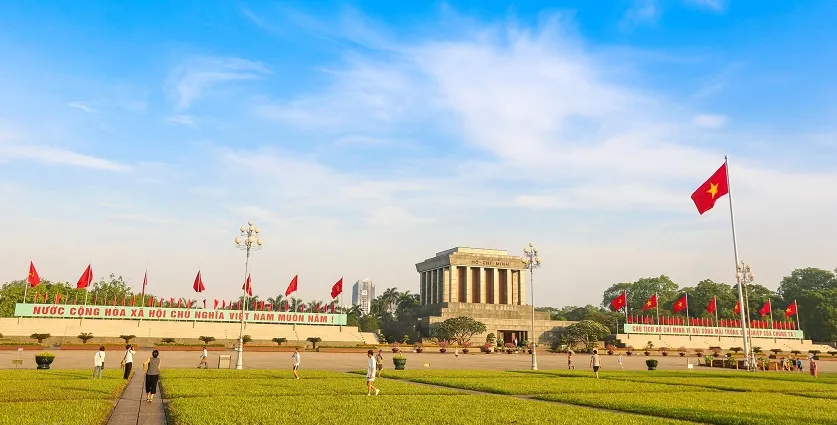
Just a short time after being renamed, Ba Dinh Square was honored to be chosen as the venue for the most important event in Vietnamese history. On September 2, 1945, at historical Ba Dinh Square, President Ho Chi Minh read the Declaration of Independence, giving birth to the Democratic Republic of Vietnam, now the Socialist Republic of Vietnam.
That historic moment has gone into the subconscious of every Vietnamese person. Ba Dinh Square on September 2, 1945, was filled with crowds and flowers, echoing the joyful cheers and happiness of millions of people who had just gained independence and freedom. Those who were present at Ba Dinh Square that day still remember in their hearts the sacred, heroic, and emotional atmosphere of that historical moment.
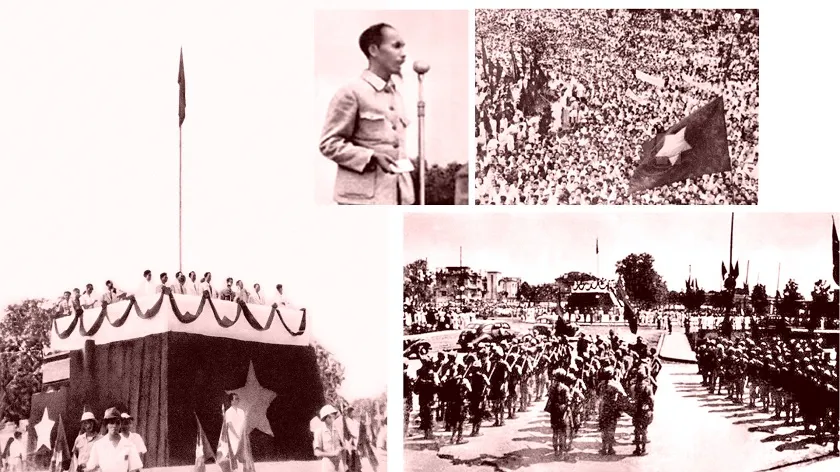
After independence day, Ba Dinh Square was also called by other names such as Independence Square or Hong Bang Square. However, in the end, the name Ba Dinh Square was retained and became the official name to this day, as a deep tribute to the historical and spiritual values that the square brings.
Currently, Ba Dinh Square proudly holds the title of the largest square in Vietnam, with an area of over 32,000 square meters. This place is not only an attractive tourist destination but also a venue for important political and cultural events of the nation such as commemorations of war heroes and martyrs, parades, rallies, reporting ceremonies, and Party admission ceremonies. Every day, Ba Dinh Square also solemnly holds the flag-raising and flag-lowering ceremonies, attracting a large number of people and tourists to witness.
Journey to Visit Ba Dinh Square
Coming to Ba Dinh Square, visitors will be impressed by the vast, airy space and unique architecture. The highlight of the square is the square-cut green lawns, stretching throughout the campus. Not only bringing aesthetic beauty, these lawns also have the effect of reducing heat, creating a cool atmosphere for the square, especially during the hot summer days of Hanoi. The grass grown in the square is ginger grass, a type of grass that is resistant to trampling and always maintains its fresh green color all year round.
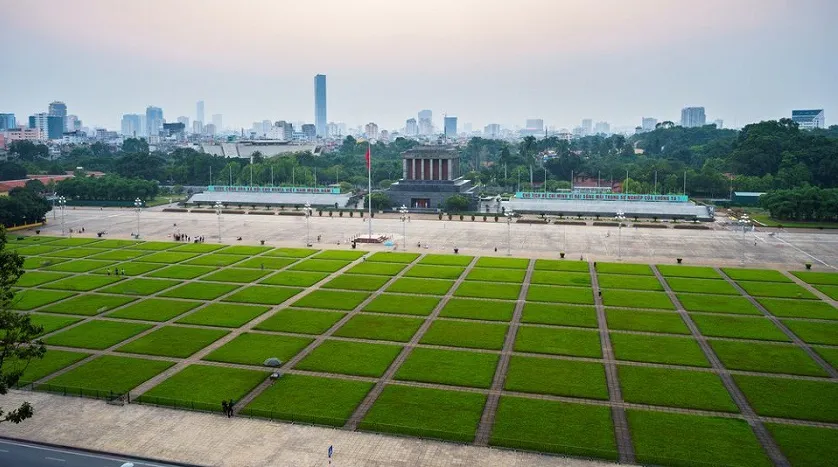
Behind Ba Dinh Square is the solemn Ho Chi Minh Mausoleum, built on the foundation of the old rostrum where President Ho Chi Minh read the historic Declaration of Independence. Ba Dinh Square and Ho Chi Minh Mausoleum form a unified and harmonious architectural complex, showing the close connection between the beloved leader and the Vietnamese nation.
One of the unmissable experiences when visiting Ba Dinh Square is watching the flag-raising and flag-lowering ceremonies. The flag-raising ceremony takes place at 6:00 AM (summer) or 6:30 AM (winter), and the flag-lowering ceremony takes place at 9:00 PM daily. The ceremony is solemnly performed by 37 soldiers of the Mausoleum Protection Command, with the leading formation being the determined-to-win military flag and 34 soldiers representing the first 34 soldiers of the Vietnam People’s Army.
In the majestic national anthem, the red flag with a yellow star is slowly raised to the top of the flagpole, fluttering in the Hanoi sky. This sacred moment always brings a sense of pride and emotion to every Vietnamese person when witnessing it.
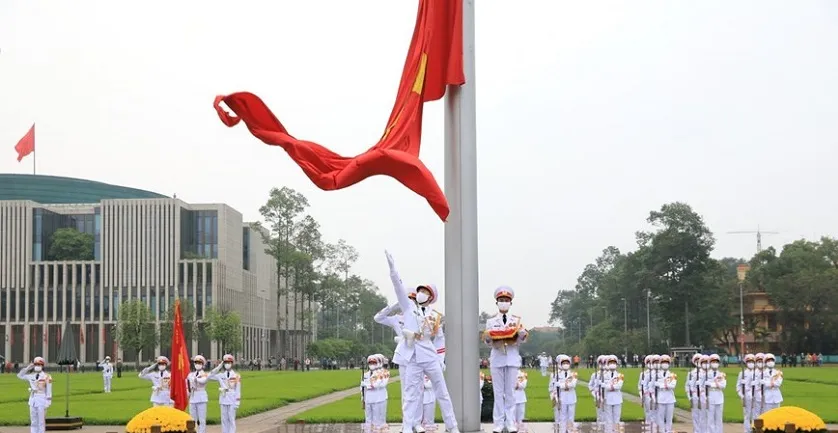
Explore Historical Sites Near Ba Dinh Square
The Ba Dinh Square complex not only includes the square itself but also many other famous historical and cultural relics, creating an attractive cultural tourism destination in Hanoi. Below are some places visitors should not miss when visiting Ba Dinh Square:
Ho Chi Minh Mausoleum – The Eternal Resting Place of The Leader
Opening hours: Open on weekdays, except Mondays and Fridays.
- Hot season (April – October): Weekdays: 7:30 AM – 10:30 AM. Weekends and holidays: 7:30 AM – 11:00 AM.
- Cold season (November – March): Weekdays: 8:00 AM – 11:00 AM. Weekends and holidays: 8:00 AM – 11:30 AM.
- Note: If May 19, September 2, and the 1st day of Lunar New Year fall on Monday or Friday, the Mausoleum is still open to visitors.
Entrance fee: Free for Vietnamese people. Foreign visitors: 25,000 VND/ticket.
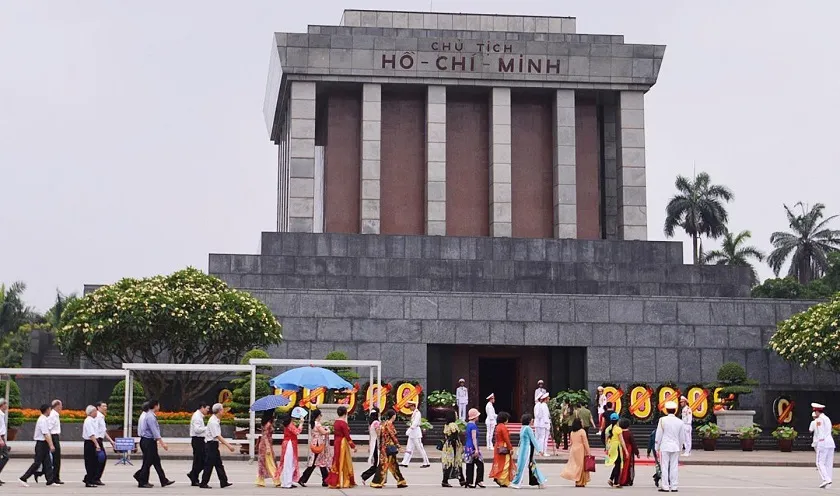
Located right behind Ba Dinh Square, Ho Chi Minh Mausoleum is the eternal resting place of the great leader of the Vietnamese nation. Since its inauguration, the Mausoleum has welcomed tens of millions of visitors, including millions of international visitors. For Vietnamese people, visiting Ho Chi Minh Mausoleum is not just a tourist activity but also an emotional need, a custom to express respect and gratitude to President Ho Chi Minh. The Mausoleum is built with simple, solemn architecture, bearing đậm nét Vietnamese culture.
Ho Chi Minh Museum – Journey to Discover The Great Life and Career
Opening hours: Open on weekdays, except Mondays and Fridays, from 8:00 AM – 11:30 AM.
Entrance fee: Free for Vietnamese people. International visitors: 40,000 VND/ticket.
Ho Chi Minh Museum is located to the south of Ba Dinh Square. This place displays thousands of precious artifacts, documents, and images about the life and revolutionary career of President Ho Chi Minh, as well as the history of building and defending the country of Vietnam. With a scientific and vivid layout, the Ho Chi Minh Museum helps visitors better understand the person, ideology, and great contributions of President Ho Chi Minh to the country.
Presidential Palace – Witnessing Ancient French Architecture
The Presidential Palace used to be the workplace of President Ho Chi Minh when he was alive. Today, the Presidential Palace is still the workplace of the President and Vice President of the country, and also becomes an important historical relic. Although not open to visitors inside, visitors can still admire the classical, luxurious French architecture of the building from the outside and take impressive souvenir photos.

Ho Chi Minh’s Stilt House and Fish Pond – Simplicity in The Presidential Palace Grounds
Opening hours: Morning: 7:30 AM – 11:00 AM, Afternoon: 1:30 PM – 4:00 PM.
Entrance fee: Free for Vietnamese people. Foreign visitors: 25,000 VND/ticket.
Located within the Presidential Palace grounds, Ho Chi Minh’s stilt house and fish pond is where President Ho Chi Minh lived and worked during his revolutionary activities and leading the country. The simple stilt house and green fish pond are proof of President Ho Chi Minh’s simple lifestyle, close to nature. Coming here, visitors can clearly feel President Ho Chi Minh’s lifestyle and noble personality.
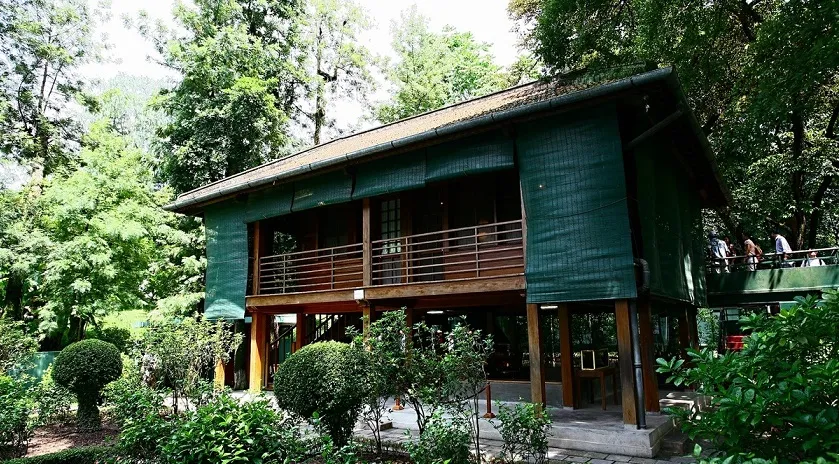
One Pillar Pagoda – Thousand-Year Cultural Symbol of Hanoi
Opening hours: 7:00 AM – 6:00 PM.
Entrance fee: Free for Vietnamese people. Foreign visitors: 25,000 VND/ticket.
One Pillar Pagoda, also known as Dien Huu Pagoda, is an ancient and unique pagoda, considered a cultural symbol of Hanoi. The pagoda is located in the park behind Ong Ich Khiem Street, near Ba Dinh Square and Ho Chi Minh Mausoleum. With its lotus-shaped architecture rising from the water, One Pillar Pagoda has a peaceful and unique beauty, attracting many tourists to visit and worship.
Directions to Ba Dinh Square
Ba Dinh Square is located in the city center of Hanoi, on Hung Vuong Street, Dien Ban Ward, Ba Dinh District. Visitors can easily get to the square by many different means of transport:
- Motorbike, personal car: Visitors can travel along Ngoc Ha Street or Ong Ich Khiem Street and park their vehicles at parking lots near the square.
- Bus: There are many public bus routes stopping near Ba Dinh Square, such as route 09 (get off at Le Hong Phong street), routes 22A and 50 (get off at Hoang Dieu street). Visitors can look up detailed information about bus routes on the bus search application or website.
- Taxi, ride-hailing services: This is a convenient and fast means of transportation, suitable for large groups or visitors who want to save time.
Travel Tips for Ba Dinh Square
To have a complete and meaningful trip to Ba Dinh Square, visitors should note some of the following tips:
- Visiting time: You should come to Ba Dinh Square in the early morning or late afternoon to avoid the heat and have a quieter space.
- Dress code: When visiting Ba Dinh Square and historical sites in the complex, visitors should choose polite and discreet clothes to show respect. Especially when visiting Ho Chi Minh Mausoleum, the dress code needs to be more formal.
- Behavior: Maintain general hygiene, do not litter indiscriminately, do not step on the lawns, do not make noise or cause disorder in the square.
- Flag-raising, flag-lowering ceremonies: If you have the opportunity to come to the square at the time of the flag-raising or flag-lowering ceremony, you should take the time to witness this solemn ceremony and show national pride.
- Visiting Ho Chi Minh Mausoleum: Ho Chi Minh Mausoleum is only open in the morning, visitors should arrive early to avoid queuing and have enough time to visit. Children under 3 years old are not allowed to visit Ho Chi Minh Mausoleum.
Ba Dinh Square is not only a famous tourist destination but also a symbol of the history, culture, and spirit of the Vietnamese nation. A trip to Ba Dinh Square will be a valuable experience, helping visitors deeply understand the heroic history and traditional cultural values of the country. Come and feel it, and let Ba Dinh Square tell you meaningful historical stories!
To make your Hanoi trip more complete, don’t forget to check out quality travel services at preferential prices from BestPrice such as flights to Hanoi and Hanoi hotels. Wish you a memorable journey to explore Hanoi capital!
BestPrice
Image source: Internet